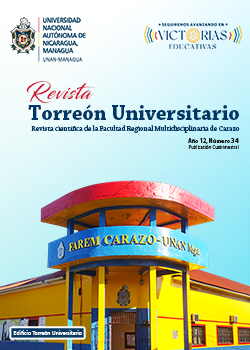Evaluation of variables of vegetative growth of amaranth (Amaranthus cruentus L.) variety Amaranteca in the Biotechnology Laboratory, National Autonomous University of Nicaragua, Managua
DOI:
https://doi.org/10.5377/rtu.v12i34.16379Keywords:
Amaranth, Vegetative growth, UNAN ManaguaAbstract
The objective of this study was to evaluate the vegetative growth variables of Amaranthus cruentus L. var. Amaranteca in Managua. The cultivation was established during the months of June-September 2010, on a property located in the Ricardo Morales Avilés University Campus - UNAN Managua, the experimental unit consisted of five rows of 50 m long, with distance between plants and rows of 50 cm, 100 kg ha-1 was fertilized with NPK (12-30-10). A direct stream sowing system was used, the emergence of seedlings occurred after four days, thinning, weed control and hilling were carried out. The maximum averages in the variables were 255 cm in Height of the plant, 109 units of leaves, 29.8 cm in Length of leaf and 4.2 cm in Diameter of the stem. Significant differences (Tukey, p> 0.05) were found between Height of the plant and Number of leaves; Stem diameter and number of leaves; and Stem diameter and size of leaves.
Downloads
References
Barba de la Rosa, A. P., Fomsgaard, I. S., Laursen, B., Mortensen, A. G., Olvera-Martínez, L., Silva-Sánchez, C., … De
León-Rodríguez, A. (2009). Amaranth (Amaranthus hypochondriacus) as an alternative crop for sustainable
food production: Phenolic acids and flavonoids with potential impact on its nutraceutical quality. Journal of
Cereal Science, 49(1), 117–121. https://doi.org/10.1016/j.jcs.2008.07.012
Comisión de Agricultura, Ganadería, Pesca y Desarrollo rural. (2019). Iniciativa con proyecto de decreto por lo que
se adiciona una fracción XII al artículo 179 de la ley de desarrollo rural sustentable, para considerar al amaranto
como producto básico y estratégico. Estados Unidos Mexicanos.
Dirección General de Meteorología. (2008). Caracterización Climática del Departamento de Managua. Instituto
Nicaraguense de Estudios Territoriales (INETER).
García Ibarra, L. (2012). Variedades de Amaranto y fechas de siembra para rendimiento de grano y forraje en San
Luis Potosí. Tesis profesional presentada como requisito parcial para obtener el título de Ingeniera Agrónoma
Fitotecnista, Universidad Autónoma de San Luis Potosí, Facultad de Agronomía.
García Pereyra, J., Valdés Lozano, C. G., Olivares Sáenz, E., Alvarado Gómez, O., Alejandré Iturbide, G., Salazar Soza,
E., & Medrano Roldán, H. (2009). Rendimiento de grano y calidad del forraje de Amaranto (Amaranthus spp.)
cultivado a diferentes densidades en el noreste de México.
Guaman Yupa, S. M. (2012). "Evaluación del potencial de rendimiento de una variedad y dos líneas de amaranto
(Amaranthus spp.) en dos sistemas de siembra, manual y mecánico en el Cantón El Tambo provincia del Cañar".
Tesis para obtener título de Ingeniería Agronómica, Riobamba-Ecuador.
López, A., & Alonso, J. A. (2019). e return of Amaranthus spp. as a potential crop for human nutrition. Rd-Icuap.
Luis, G. M., Hernández Hernández, B. R., Peña Caballero, V., Torres López, N. G., Espinoza Martínez, V. A., &
Ramírez Pacheco, L. (2018). Usos actuales y potenciales del Amaranto (Amaranthus spp.). Journal of Negative
and No Positive Results, 3(6), 423-436.
Monsalvo Jiménez, C., & Oliver Guadarrama, R. (2004). Producción de Amaranto (Amaranthus hypocondriacus L.)
a tres fechas de siembra en Huazulco, Temoac, Morelos. 10.
Olán, M. D., Espitia Rangel, E., Ayala Garay, A. V., Hernández Casillas, J. M., Arellano Vázquez, J. L., & Ruiz
Hernández, V. C. (2012). Caracterización morfológica de germoplasma para grano de amaranto (Amaranthus
spp.). En E. Espitia Rangel, & E. Espitia Rangel (Ed.), Amaranto: Ciencia y Tecnología. Libro Científico No. 2.
INIFAP/SINAREFI. (Primera ed., págs. 165-181). México.
Paredes López, O., & Hernández López, D. (1992). Food Properties of Amaranth Seeds and Methods for Starch
Isolation and Characterization. En Linskens, H.F., Jackson, J.F. (eds) Seed Analysis (Vol. 14, págs. 217–239).
doi:https://doi.org/10.1007/978-3-662-01639-8_11
Svirskis, A. (2003). Investigation of amaranth cultivation and utilisation in Lithuania. Agronomy Research, 1(2), 253–
Obtenido de https://www.doc-developpement-durable.org/file/Culture/Culture-plantes-alimentaires/
FICHES_PLANTES/amarante/testing%20amaranth%20in%20Lithuania.pdf
Zelaya Morales, M. Y. (2015). Evaluación agronómica de la variedad adaptada de amaranto (Amaranthus spp) bajo
las condiciones climáticas en el Centro de Desarrollo Tecnológico CDT-INTA San Isidro, del departamento
de Matagalpa, año 2015. Monografía para optar al Título de Ingeniería Agronómica, Universidad Nacional
Autónoma de Nicaragua, Managua. FAREM Matagalpa.
Published
How to Cite
Issue
Section
License
Copyright (c) 2023 National Autonomous University of Nicaragua, Managua

This work is licensed under a Creative Commons Attribution-NonCommercial-NoDerivatives 4.0 International License.
Los autores que publican en esta revista están de acuerdo con los siguientes términos.
- El autor o los autores de los artículos, ensayos o investigaciones conceden a la Universidad Nacional Autónoma de Nicaragua, Managua (UNAN-Managua) los derechos de edición (copyright) del trabajo enviado, por consiguiente la Universidad cuenta con el derecho exclusivo para publicar el artículo durante el periodo completo de los derechos de autor.
- Estos derechos de autor/ autores autorizan a la Revista Torreón Universitario y a la Universidad editar y divulgar/publicar el artículo en dicha Revista, incluyendo reproducción impresa y electrónica, el almacenamiento, recuperación y cualquier otro tipo de publicación, y fuentes de información secundaria como servicios de resúmenes y bases de datos, así mismo la facultan a proteger el artículo contra el uso no autorizado para su difusión por medios impresos o electrónicos (PDF, HTML, EPUB, XML u otros).
Licencia para el uso del contenido
La revista hace uso de la Licencia Creative Commons Atribución-NoComercial-SinDerivar 4.0 Internacional.
Bajo esta declaración:

Este revista está sujeta a una licencia de Creative Commons Reconocimiento-NoComercial-SinObraDerivada 4.0 Internacional. Puede ser copiada, distribuida y transmitida públicamente siempre y cuando se cite al autor y la fuente (Revista Torreón Universitario), no debe modificarse ni utilizarse con ningún fin comercial. La licencia completa se puede consultar en http://creativecommons.org/licenses/by-nc-nd/4.0/.

